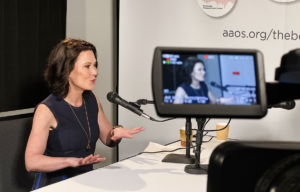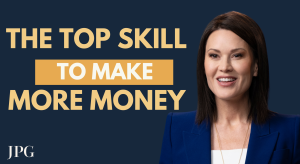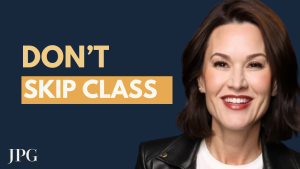The first time I presented after starting my company was a nightmare.
I was terrible.
A major Chicago publisher asked me to talk about how small businesses can land TV interviews. There were about 100 people in the room.
I wasn’t that nervous.
But I felt like I had to prove myself.
So I spit out about three hours of information in about 45 minutes.
It was too much. I was not entertaining. I never told a story. I never paused to let them absorb. I didn’t read body language.
I just “puked” information at them.
How could they absorb it? I was going too fast. There was no way to make an impact.
I sucked. I failed. I was never asked back.
I didn’t let it stop me.
In the seven years since then, I’ve presented hundreds of times.
I’m more prepared now. Audiences learn more from me. I’m more memorable. I’m asked back over and over again.
How can you be asked back and be more memorable when giving a presentation online?
Here’s my 3-part framework
It can feel impossible to have a meaningful connection with your audience online. Some executives think it’s okay to just fly through slides for 45 minutes. It’s not. That’s the easiest way to lose people and not be invited back to speak.
Before Your Presentation
The key to being a successful presenter is changing your mindset from a “speaker” to someone having a conversation with a group of people. But, of course, it’s not a real conversation unless you know them and can see them. Here’s how to do that: Do not present blindly.
Do not present blindly.
- Empower yourself to ask questions ahead of time about your audience to help you build a better presentation. You need to know them, so you know what to teach them.
- Ahead of time, practice the technical aspects of Zoom or Microsoft Teams so you can see the faces in the audience. If you can’t see them, that’s a technical problem you need to figure out ahead of time. Invest in a second screen to help you see more windows.
During the presentation
Here’s where the magic happens. Like to dance? We don’t just pick someone up and throw them around the dance floor. You move and your dance partner moves according to your body’s movement. It’s similar when presenting. Here’s how:
Watch your audience.
- Look at your audience once in a while. You should know your slides well enough that you’re not reading them, and instead, you’re looking at people’s reactions while you’re presenting. This lets you gauge their reactions and adjust as you go. They don’t like that you sped up your dancing feet? You’ll be able to see that and feel it. They will look lost. They’ll start checking their phones. Watch their body language.
- Don’t be afraid to speak to it directly if you’re losing people. “It looks like I’ve lost some of you – is there a specific question I can answer?” See frowns? Don’t be afraid to speak to that. “I’m seeing many of you may disagree with what I just said. What am I missing?” People will appreciate your honesty, and you’ll be much more effective in teaching the information.
- Change your presentation in real-time. Your audience is giving you feedback and telling you what they need. You, as the speaker, need to react because this is a two-way conversation.
- Try to stand if possible. Raise your desk or prop your computer and camera on something higher. This helps get more oxygen to your brain. When you slouch, you compress the space for your lungs, reducing capacity and sending less oxygen to your brain. When you have increased oxygen flowing to your head, your brain functions better, helping you think, focus and concentrate better. If you have to sit, be sure to sit nice and tall in the front one-third of your seat.
- Be sure to give adequate breaks. If you see people dancing in their seats at that hour spot, provide them with the option of a quick break. They can’t concentrate with full bladders (I do an earlier break for those first thing in the morning presentations).
At the end of your presentation
The end of the presentation is when you share your email and website, right?
No.
The call-to-action is not your closer.
- If you have an “ask” or a “call to action,” don’t make that the end. End on a solid note they’ll remember. Ending with “go to our website” is not a powerful way to end a presentation.
- When you do so well, there will be a lot of questions. Do everything possible to finish on time – to respect their time. You can always follow up with the organizers and offer another presentation or send supporting materials to the audience. It would be great to email them within 24 hours while you’re still on their mind.
- Also, offer the organizers ideas for future presentations. Before you know it, you’ll be back to present to a new group eager to hear what you have to share with them.
You’ve got this!
P.S. Want more tips? Be sure to sign up for my LinkedIn newsletter where you’ll get exclusive tips on strengthening your mindset to become a better communicator. Click here to subscribe to Thought Leaders Amplified on LinkedIn.
P.P.S. I created a training program for healthcare professionals who need to discover their message and story, deliver it clearly, succinctly, and confidently, and present in a way that intrigues, entertains and keeps the audience’s attention. Share it with your friends in healthcare. Check it out even if you’re not in healthcare. The tips and tricks are universal. Click here to learn more.
P.P.P.S. Whenever you’re ready… here are a few more ways I can help you build your brand, own your voice, and stand out:
- Need actionable strategies to be a more trusted, authentic, confident, and inspiring thought leader? I just launched a podcast called Thought Leaders Amplified – you can listen to it here.
- Want more tactical advice you can implement today? Check out my blog here for great articles, stories, and lessons I’ve shared over the years.
- Looking for one-on-one coaching or a consultation with me? Schedule a complimentary call here to speak to our team about how we can help you.
- Follow me on Instagram here for more media and public speaking tips, videos… and a little fun.





